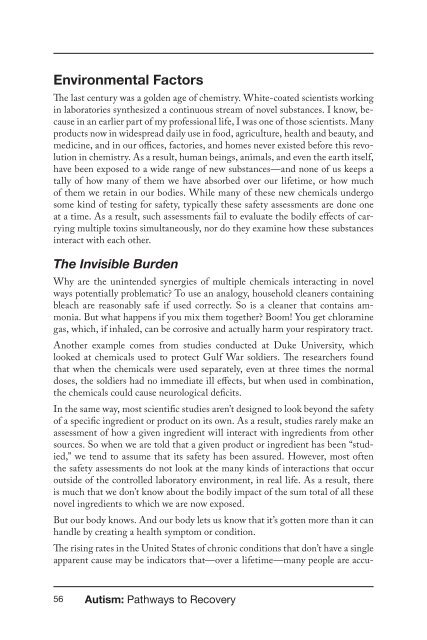3dT4E4Rnm
3dT4E4Rnm
3dT4E4Rnm
Create successful ePaper yourself
Turn your PDF publications into a flip-book with our unique Google optimized e-Paper software.
Environmental Factors<br />
The last century was a golden age of chemistry. White-coated scientists working<br />
in laboratories synthesized a continuous stream of novel substances. I know, because<br />
in an earlier part of my professional life, I was one of those scientists. Many<br />
products now in widespread daily use in food, agriculture, health and beauty, and<br />
medicine, and in our offices, factories, and homes never existed before this revolution<br />
in chemistry. As a result, human beings, animals, and even the earth itself,<br />
have been exposed to a wide range of new substances—and none of us keeps a<br />
tally of how many of them we have absorbed over our lifetime, or how much<br />
of them we retain in our bodies. While many of these new chemicals undergo<br />
some kind of testing for safety, typically these safety assessments are done one<br />
at a time. As a result, such assessments fail to evaluate the bodily effects of carrying<br />
multiple toxins simultaneously, nor do they examine how these substances<br />
interact with each other.<br />
The Invisible Burden<br />
Why are the unintended synergies of multiple chemicals interacting in novel<br />
ways potentially problematic To use an analogy, household cleaners containing<br />
bleach are reasonably safe if used correctly. So is a cleaner that contains ammonia.<br />
But what happens if you mix them together Boom! You get chloramine<br />
gas, which, if inhaled, can be corrosive and actually harm your respiratory tract.<br />
Another example comes from studies conducted at Duke University, which<br />
looked at chemicals used to protect Gulf War soldiers. The researchers found<br />
that when the chemicals were used separately, even at three times the normal<br />
doses, the soldiers had no immediate ill effects, but when used in combination,<br />
the chemicals could cause neurological deficits.<br />
In the same way, most scientific studies aren’t designed to look beyond the safety<br />
of a specific ingredient or product on its own. As a result, studies rarely make an<br />
assessment of how a given ingredient will interact with ingredients from other<br />
sources. So when we are told that a given product or ingredient has been “studied,”<br />
we tend to assume that its safety has been assured. However, most often<br />
the safety assessments do not look at the many kinds of interactions that occur<br />
outside of the controlled laboratory environment, in real life. As a result, there<br />
is much that we don’t know about the bodily impact of the sum total of all these<br />
novel ingredients to which we are now exposed.<br />
But our body knows. And our body lets us know that it’s gotten more than it can<br />
handle by creating a health symptom or condition.<br />
The rising rates in the United States of chronic conditions that don’t have a single<br />
apparent cause may be indicators that—over a lifetime—many people are accu-<br />
56 Autism: Pathways to Recovery


